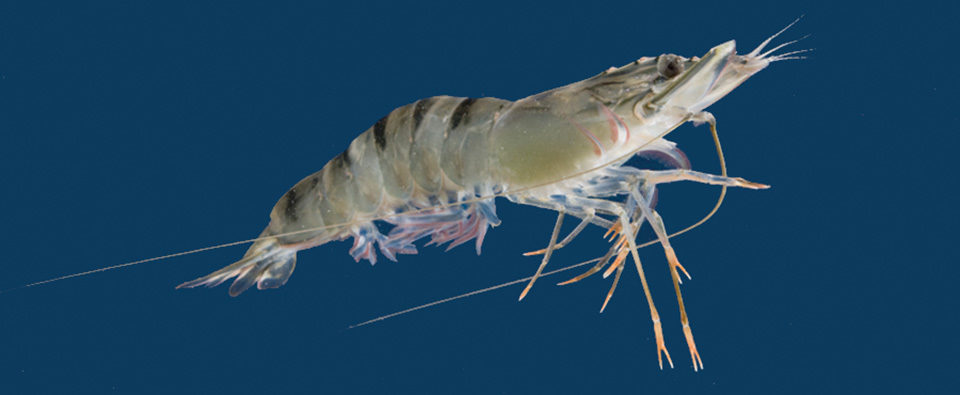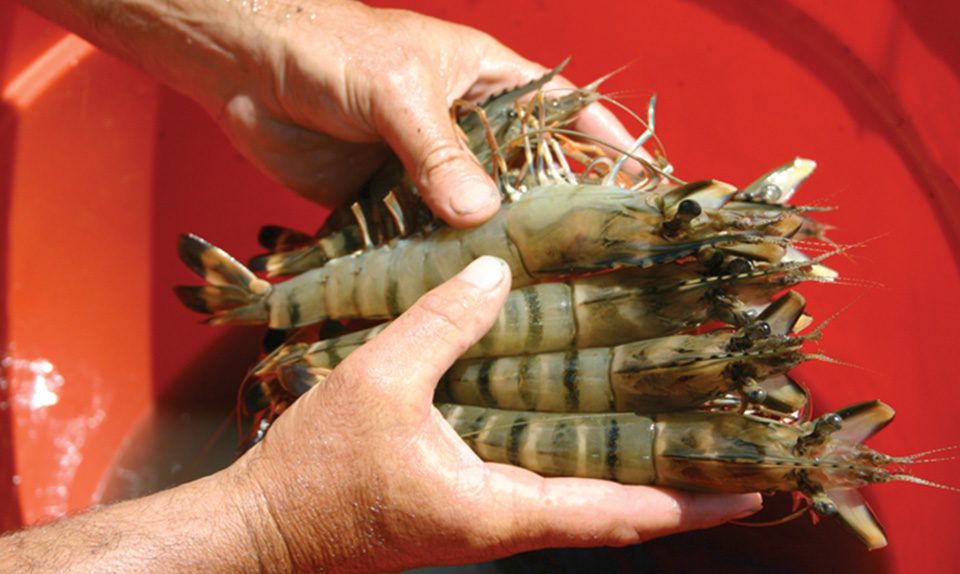Biosecure production, genetic markers assist development

Over the past decade, the global production of farmed white shrimp (Litopenaeus vannamei) has continued to expand throughout the major shrimp-farming regions of the world. The most dramatic increases have been in Asia, particularly in China, Thailand and Vietnam, where L. vannamei have progressively replaced native species such as the black tiger shrimp (Penaeus monodon), which was the dominant farmed species until 2003.
The dominant place that P. monodon held in global shrimp farm production was due to a number of factors, including their rapid growth rate, large harvest size and relatively high market price. While these characteristics are still very favorable for shrimp farmers, the Achilles heel for P. monodon has been the lack of success in its domestication and selective breeding.
The reliance of P. monodon farmers on wild broodstock and associated risks of lack of adaptation to the production environment and susceptibility to pathogens contributed to the move away from the species. In contrast, the domestication and selective breeding of specific pathogen-free stocks of L. vannamei has had a phenomenal impact on the adoption of this species by the global shrimp farming industry.
Pond rearing
A key factor that may have hampered progress in the domestication of P. monodon has been the many attempts to produce the earliest generations of domesticated broodstock in open-environment ponds. The transition from the natural environment to shrimp production ponds, particularity high-intensity ponds, is a challenge for any shrimp species.
For most species, the progeny of wild broodstock survive and grow reasonably well in ponds until they are harvested as young adults. In this respect, P. monodon outperform other farmed shrimp species, being able to reach commercial harvest sizes of 30 to 35 g in a shorter time. This was a main reason for the popularity of P. monodon in an era when the global shrimp industry relied almost entirely on wild broodstock.
However, the capacity for undomesticated shrimp stocks to survive and develop into healthy, reproductively mature adults in production ponds is a significant challenge for all shrimp species, particularly P. monodon. It is possible that the progeny of wild P. monodon are particularly susceptible to viral infections, especially when they are coupled with rapid fluctuations in environmental conditions.

Controlled, biosecure rearing
The alternative to producing shrimp broodstock in open ponds is to rear the progeny from egg to reproductive adults in biosecure, controlled environment facilities that more closely mimic the natural environment of wild broodstock. A critical component of this strategy is to screen the parent broodstock for pathogenic viruses. This strategy resulted in the highly successful domestication of L. vannamei and the subsequent progressive gains in genetic improvement via selective breeding.
More recently, biosecure rearing led to significant progress in commercial-scale domestication and selective breeding of P. monodon in Australia. Australian stocks of P. monodon reared for five generations in controlled-environment tanks and raceways had a 10-fold higher nauplii production than first-generation broodstock. Furthermore, yields from ponds stocked with the progeny of fifth-generation P. monodon broodstock were up to 60 percent higher than from adjacent ponds stocked with the progeny of wild broodstock.
Costs, comparisons
The success achieved in P. monodon has the potential to rapidly increase the availability of high-health, specific pathogen-free stocks and to develop specific pathogen-resistant stocks. Although these developments would provide farmers with an option to switch back to P. monodon or trial the species with lower risks than stocking ponds with the progeny of wild broodstock, the future for P. monodon will ultimately be determined by production costs.
In the absence of domesticated, selectively bred P. monodon, it has not been possible to rigorously test assumptions about the relative benefits of farming L. vannamei and P. monodon. Comparison of the performance of the progeny of wild broodstock with that of the progeny of domesticated stocks would clearly favor the latter.
With the emerging opportunity to test like with like, comparisons between selectively bred L. vannamei and P. monodon for basic production traits such as survival, growth and disease tolerance may soon be possible. There is also increasing interest in evaluating the amenability of both species to intensive culture technology and the ability to perform well on lower-protein feeds.
These latter traits are currently the domain of L. vannamei. Nevertheless, the inherent capacity for rapid growth, large harvest size and associated high market price of P. monodon may yet provide farmers with an opportunity to emulate the global success that L. vannamei producers have achieved via selective breeding.
Genetic opportunity
As the future of farmed P. monodon unfolds, there is an opportunity to track the genetic changes that take place using molecular tools and techniques that were simply not available when L. vannamei domestication and breeding programs developed. In Australia, genetic markers are currently being used to assess genetic diversity in wild stocks, track changes in diversity in domesticated stocks and assign pedigrees within selective-breeding programs.
Genetic markers are also being used to explore the potential of natural mating as a practical alternative to artificial insemination without compromising effective genetic management of the breeding stocks. The application of genetic markers should enhance the capacity of the P. monodon industry to optimize selective-breeding programs for the species.
Editor’s Note: This article was partly based on the review paper “Advances in Penaeusmonodon Breeding and Genetics” included in the proceedings of the Sustainable Shrimp Farming session of World Aquaculture 2009 in Veracruz, Mexico.
(Editor’s Note: This article was originally published in the July/August 2009 print edition of the Global Aquaculture Advocate.)
Now that you've finished reading the article ...
… we hope you’ll consider supporting our mission to document the evolution of the global aquaculture industry and share our vast network of contributors’ expansive knowledge every week.
By becoming a Global Seafood Alliance member, you’re ensuring that all of the pre-competitive work we do through member benefits, resources and events can continue. Individual membership costs just $50 a year. GSA individual and corporate members receive complimentary access to a series of GOAL virtual events beginning in April. Join now.
Not a GSA member? Join us.
Authors
-
Nigel Preston, Ph.D.
CSIRO Food Futures Flagship
CSIRO Marine and Atmospheric Research
P.O. Box 120
Queensland 4163 Australia -
Greg Coman, Ph.D.
CSIRO Food Futures Flagship
CSIRO Marine and Atmospheric Research
Tagged With
Related Posts

Health & Welfare
Brunei project develops technology for large black tiger shrimp production, part 1
A five-year project was undertaken in Brunei Darussalam to develop advanced technology for the production of large black tiger shrimp. A combination of technologies has enabled efficient production of large-sized black tiger shrimp, which could lead to a resurgence of this species in Asia.

Health & Welfare
Brunei project develops technology for large black tiger shrimp production, part 3
Specific pathogen-free offspring developed from founder populations of P. monodon collected from Brunei coastal waters were introduced into a biosecure breeding program, where they have been reared to the fifth generation using family-based selection for reproduction and growth.

Health & Welfare
Brunei project develops technology for large black tiger shrimp production, part 2
For a five-year project undertaken in Brunei Darussalam to develop advanced technology for production of large black tiger shrimp, a comprehensive disease diagnostic laboratory was developed to enable detection of known and emerging shrimp pathogens by molecular and histological methods.

Health & Welfare
Brunei project develops technology for large black tiger shrimp production, part 4
Nutrition research run in conjunction with the breeding program ensures that cost-effective feeds are optimized for shrimp performance for a five-year project undertaken in Brunei Darussalam to develop advanced technology for production of large black tiger shrimp.


